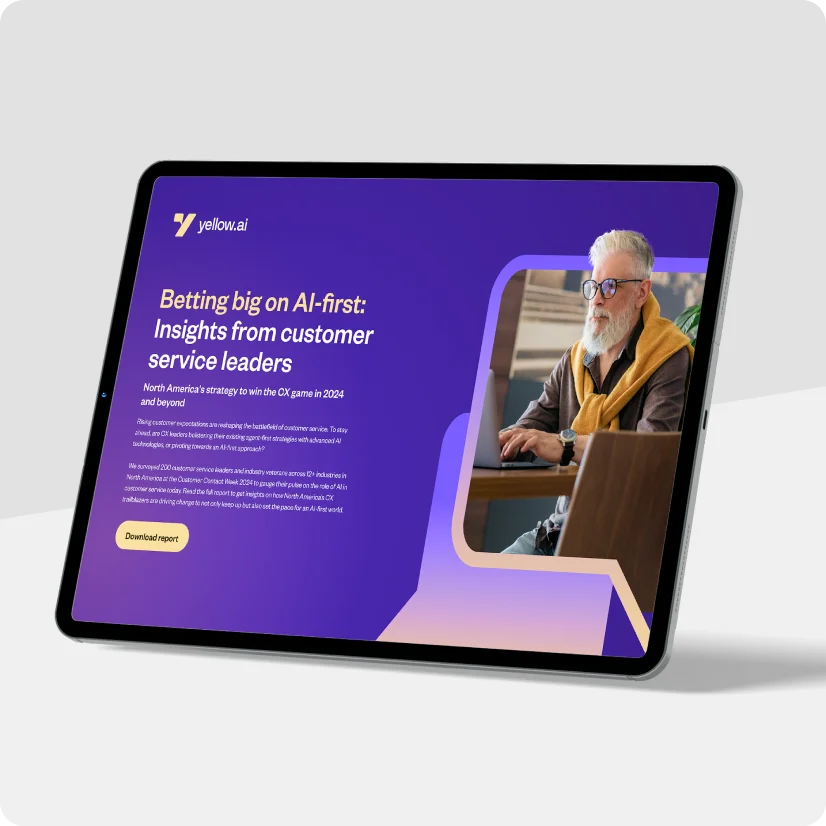Executive summary
Digital interaction is the king in today’s era, and learning how to create a chatbot has become an essential skill for businesses. This guide explains how to make a chatbot and the nuances of chatbot creation. It also explores aspects from the initial conception to deployment. Besides explaining the steps to create a bot, the guide also answers questions like why to make a chatbot for a website. We also highlight the role of conversational AI, choosing the right type of chatbot, and a step-by-step guide to create a bot without coding.
Chatbots have swiftly moved from being a novelty to a necessity in the digital business landscape. Their ability to streamline customer interactions, offer instant support, and gather vital data has made them indispensable tools. However, despite their prevalence, the thought of creating a chatbot can still seem daunting to many. The good news? It’s neither as complex nor as technical as it once was. Today, platforms like Yellow.ai have democratized chatbot creation, allowing businesses of all sizes to build and integrate sophisticated chatbots with ease and without the need for extensive coding knowledge.
The chatbot market is witnessing a surge, with a projected growth rate that underscores their increasing importance in customer service and engagement. This growth is a response to a clear market need. With chatbots, businesses are not only keeping up with technological advancements but are also meeting the ever-evolving expectations of their customers. Whether you’re looking to enhance customer service, improve engagement, or streamline internal processes, this article will help you navigate the chatbot landscape with confidence and clarity.
Related must-reads:
- Customer service chatbots: Benefits and examples [2023]
- 9 Real life chatbot examples [well-known brands]
- 30 Chatbot applications from six key industries
- Chatbot design – How to design a successful chatbot?
- Chatbot integration with multiple channels
Chatbot market overview: Navigating the 2024 landscape
As we approach 2024, the chatbot market continues to expand, driven by businesses’ growing need for efficient customer service and streamlined operations. Let’s understand the current state of the chatbot market, highlighting key data and forecasts that paint a picture of this technology’s increasing relevance.
Related read: Chatbot statistics – Understanding the AI revolution in business
Market valuation: As of 2022, the global chatbot market stood at a valuation of approximately $4.7 billion. This figure reflects the escalating demand for chatbots across various industries and their pivotal role in digital communication strategies.
Forecasted growth: The market is projected to experience substantial growth, with forecasts suggesting an increase from $5.4 billion in 2023 to an impressive $15.5 billion by 2028. It represents a Compound Annual Growth Rate (CAGR) of around 23.3% during this period, underscoring the rapid adoption and integration of chatbot technologies in business environments.
Dominant sectors: The contact center segment is expected to dominate the market share in the coming years. Chatbots’ ability to handle routine customer queries efficiently frees human agents to address more intricate issues. Besides streamlining customer service operations, it also enhances the overall quality of customer support.
Mobile integration: Another significant trend is the rise of mobile app chatbots. Integrated into popular messaging platforms like WhatsApp, Facebook Messenger, and Telegram, these mobile app chatbots are becoming essential tools for assisting users in tasks ranging from form filling to personalized recommendations based on user behavior and preferences.
Emergence of menu-based chatbots: There’s also an expected surge in the adoption of menu-based chatbots. These chatbots, which navigate users through conversations via predefined menus and options, are particularly effective in scenarios where user inputs are limited and specific, such as in food ordering, appointment scheduling, or accessing FAQs.
Data source: Markets and Markets
Why should you make a chatbot for your website?
Integrating a chatbot into your website is a strategic business decision that can significantly enhance user experience and operational efficiency. Let’s explore the benefits of chatbots on your website.
1. 24/7 availability and instant support:
Chatbots excel in providing 24/7 assistance. Unlike human agents, they don’t need breaks, ensuring that your customers receive immediate responses at any hour. This constant availability is vital in an era where timely interaction can significantly influence customer loyalty and satisfaction.
2. Cost-effective customer service:
A remarkable benefit of chatbots is their cost efficiency. By automating routine queries, they reduce the demand on human customer service teams, allowing them to focus on more complex tasks. This efficiency can lead to a notable decrease in operational costs, with AI chatbots capable of resolving up to 69% of customer queries from start to finish, potentially reducing customer service costs by 30%.
3. Enhanced user experience:
Chatbots enhance the user journey on your site by guiding visitors, offering product recommendations, and aiding in transactions. This level of interaction boosts user engagement and satisfaction, making the website more intuitive and user-friendly.
4. Lead generation and qualification:
Chatbots are powerful tools for identifying and nurturing potential leads. They interact with visitors in real time, gather key information, and can direct them to suitable resources or contacts, enhancing the chances of conversion.
Related read: Lead generation chatbots: Top 5 benefits in 2024
5. Collecting valuable data and insights:
Chatbots are invaluable for gathering customer data. This data is crucial for tailoring marketing strategies and improving product offerings. Analyzing chatbot interactions provides insights into customer preferences and behavior, helping you make informed business decisions.
6. Scalability and adaptability:
As your business grows, so do your service needs. Chatbots offer a scalable solution capable of handling increased interaction volumes without proportionally increasing human resources. They can also adapt to changing business requirements or customer expectations, making them a long-term asset for your website.
The role of conversational AI in chatbots
The integration of conversational AI into chatbots marks a significant leap from basic automated responses to advanced, intelligent interactions. Let’s explore how conversational AI revolutionizes chatbot functionalities, catering to modern business needs.
Related read: Chatbots Vs Conversational AI – What’s the Difference?
Role1: Enhancing understanding and personalization:
Natural Language Processing (NLP) and Machine Learning (ML) are at the core of conversational AI. These technologies enable chatbots to understand human speech and text in a nuanced manner. They go beyond literal interpretations, grasping the context, emotions, and intentions behind user queries. This ability ensures that interactions are not just transactional but personalized and contextually relevant, making each customer feel understood and valued.
Role2: Automated yet human-like interactions:
The beauty of conversational AI is its ability to simulate human conversation. Unlike basic chatbots that follow rigid scripts, AI-driven chatbots can adapt their responses based on the conversation flow. They can handle a wide range of queries, from simple FAQs to more complex inquiries, all while maintaining a conversational tone that resonates with users.
Role3: Continuous learning and improvement:
Another significant aspect of conversational AI is its capability to learn from interactions. Each conversation a chatbot engages in becomes a data point for future reference. Over time, the AI system becomes more adept at understanding user preferences, enhancing the accuracy and relevance of its responses. This continuous learning process ensures that chatbots remain effective and up-to-date with evolving user needs.
Role4: Handling complex queries with ease:
The advanced algorithms of conversational AI equip chatbots to handle more complex and varied customer inquiries. This capability not only improves customer satisfaction by providing timely and relevant solutions but also reduces the reliance on human intervention for standard queries, thereby optimizing resource allocation.
Role5: Data-driven customer insights:
Conversational AI tools excel at gathering and analyzing customer interaction data. This analysis provides businesses with valuable insights into customer behavior, preferences, and trends, enabling them to make informed decisions and tailor their strategies to meet customer expectations better.
Role6: Seamless integration across platforms:
Conversational AI allows for the seamless integration of chatbots across various digital platforms, including websites, social media, and mobile apps. This versatility ensures that businesses can maintain consistent and efficient communication with their customers across all touchpoints, reinforcing brand presence and enhancing customer service.
Types of chatbots and how to choose the right one for your website
Selecting the ideal chatbot for your website is crucial for enhancing customer engagement and streamlining operations. Understanding the different types of chatbots and their unique functionalities can help you make an informed choice. Let’s dive into the various types of chatbots and how to select the most suitable one for your business needs.
Related read: 6 Types of chatbots – How to choose the best for your business?
Menu/button-based chatbots
- Functionality: These are the most basic types of chatbots, guiding users through a series of predefined options and menus. Think of them as interactive FAQs, where users click on options to get answers.
- Best for: Businesses with straightforward customer queries and those looking to implement a simple, cost-effective solution for basic customer interaction.
- Choosing for your website: If your customer interactions are predictable and can be categorized easily, a menu-based chatbot can be a quick and effective solution.
Linguistic or rule-based chatbots
- Functionality: They operate based on predefined rules and respond to specific user inputs. They are more advanced than menu-based chatbots and can handle a broader range of queries.
- Best for: Websites with a moderate level of customer interaction complexity, where responses can be predetermined based on likely customer queries.
- Choosing for your website: Select this type if your customer queries are diverse but can be anticipated and scripted in advance.
Keyword recognition-based chatbots
- Functionality: These chatbots respond to customer inquiries by recognizing keywords in the user’s input. They are more dynamic than rule-based chatbots but can struggle with overlapping keywords in different queries.
- Best for: Businesses that require a level of customization in responses but where the queries are still relatively straightforward.
- Choosing for your website: Ideal if your customer interactions involve varied phrases or sentences around similar topics.
Machine learning chatbots
- Functionality: These use AI and ML to learn from interactions and improve over time. They are capable of handling complex queries and offering personalized responses.
- Best for: Complex customer service environments where queries are highly varied and require a sophisticated understanding of language and context.
- Choosing for your website: Opt for this if you need a highly adaptable chatbot that can handle a wide range of customer behaviors and preferences.
Hybrid chatbots (Generative AI bots + traditional bots)
- Functionality: Combines the simplicity of rule-based chatbots with the sophistication of AI chatbots, offering a balance between predictability and adaptability.
- Best for: Businesses seeking a middle ground, with the reliability of rule-based responses and the adaptability of AI learning and generative AI.
- Choosing for your website: Suitable if you desire both structured responses for common queries and AI-driven interactions for more complex questions.
Voice bots
- Functionality: These are voice-activated chatbots, like Siri or Alexa, offering a hands-free, conversational experience.
- Best for: Businesses aiming to provide an interactive, voice-driven experience, especially useful for mobile users or in hands-free environments.
- Choosing for your website: This is ideal if your target audience prefers voice interaction or your services are conducive to voice commands.
Selecting the right chatbot for your website
To choose the right chatbot, consider your business needs, the complexity of customer interactions, and your technical capabilities. If your customer queries are simple and structured, a menu or rule-based chatbot may suffice.
For more complex interactions requiring personalized responses, an AI-driven chatbot is a better fit. Also, consider the user experience on your website – whether your customers would prefer a more guided interaction with menu options or a free-form chat experience. Remember, the goal is to enhance user engagement and streamline operations, so choose a chatbot that aligns with your business objectives and customer preferences.
How to make a chatbot for your website: A no-code approach with Yellow.ai
Creating a chatbot for your website doesn’t have to be a daunting task, especially with no-code platforms like Yellow.ai. This step-by-step guide will walk you through the process of creating an effective chatbot tailored to your business needs without the necessity for in-depth coding knowledge.
1. Identify the purpose and scope of the chatbot
Before diving into chatbot creation, clarify what you want your chatbot to achieve. Is its primary function customer support, lead generation, or perhaps handling transactions? Understanding its purpose will guide your design and content decisions, ensuring your chatbot meets specific business objectives.
2. Decide where you want it to appear
Determine where on your website the chatbot will be most effective. Whether it’s on the landing page to greet visitors, on product pages for instant support, or on the contact page for quick queries, placing your chatbot strategically can significantly enhance user interaction.
3. Choose the chatbot platform
Platforms like Yellow.ai make it simple to create and deploy chatbots. With its user-friendly interface, you can build a chatbot that aligns with your website’s requirements and your business’s branding, all without writing a single line of code. Start by signing up to Yellow.ai and embark on the seamless journey to create your chatbot.
So, ready to transform your digital interactions?
Witness the revolution in chatbot technology firsthand

4. Design the chatbot conversation in a chatbot editor
Yellow.ai provides an intuitive chatbot editor where you can design your chatbot’s conversation flow. Here, you can set up dialogues, responses, and actions that your chatbot will carry out, ensuring a smooth and logical conversation path for users.
5. Test your chatbot
Before going live, thoroughly test your chatbot to ensure it responds as expected. Check for any glitches or non-responsive elements in the conversation flow. This step is crucial to ensure a seamless user experience.
6. Deploy and maintain the bot
Once tested and trained, deploy your chatbot on your website. However, deployment isn’t the final step. Regular maintenance is necessary to ensure the chatbot continues to function effectively and incorporates any required updates or changes.
7. Collect feedback from users
Gather feedback from users interacting with your chatbot. This feedback is invaluable for making necessary improvements and adjustments to enhance the chatbot’s performance and user satisfaction.
8. Monitor chatbot analytics to improve it
Utilize Yellow.ai’s analytics tools to monitor your chatbot’s performance. Analyzing interactions and user responses can provide insights into how to further refine and optimize your chatbot for better results.
Related read: Chatbot analytics – 20 Metrics you must track in 2024
Yellow.ai simplifies the process of creating a chatbot with a range of features:
Easy sign-up and bot Access: Quickly sign up and choose from creating a bot from scratch or using predefined templates.

Versatile bot creation options: Whether you need a simple FAQ bot or a complex AI-driven assistant, Yellow.ai offers the flexibility to create a chatbot that meets your specific requirements.

No-code bot building: With Yellow.ai’s intuitive platform, you can build and customize your chatbot without any coding expertise, making the process accessible to everyone.
Seamless integration and deployment: Easily integrate the chatbot into your website and deploy it effectively, with support for various digital platforms. Read more: Yellow.ai Doc
Continuous learning and improvement: Yellow.ai’s chatbots are equipped to learn from interactions and evolve, ensuring they stay relevant and effective.
By choosing Yellow.ai, you can leverage the power of AI to create a chatbot that not only enhances user experience but also contributes significantly to your business goals.
How Yellow.ai can help you build an AI chatbot
Creating AI chatbots has been made super easy with Yellow.ai’s Dynamic Automation Platform. This no-code development platform enables the quick construction of intelligent AI chatbots, enhancing customer engagement without the need for extensive coding or training. Yellow.ai’s approach simplifies the chatbot design process through generative AI tools like the Dynamic Conversation Designer, Prompt Generator, Customer Lifecycle Optimizer, and more! Additionally, Yellow.ai seamlessly integrates with 100+ existing tech stacks, ensuring a smooth and cohesive operation.
Want to build your AI chatbot in minutes – no coding, no training required?

The final word on chatbot creation
Embracing chatbot technology is not just about keeping pace with digital transformation; it’s about actively enhancing customer experiences, optimizing operational efficiency, and staying ahead in a competitive market. The future beckons businesses to integrate these AI-powered conversational tools, not merely as add-ons but as integral elements of their digital strategy.
Frequently asked questions (FAQs)
How to build a chatbot using AI?
Building an AI-powered chatbot involves selecting a platform like Yellow.ai, defining the bot’s purpose, designing conversational flows in a no-code editor, and testing and training the bot with relevant data. AI chatbots use technologies like Natural Language Processing (NLP) to understand and respond to user queries effectively.
How long does it take to implement a chatbot?
The time to implement a chatbot can vary based on complexity. Simple chatbots can be deployed in a few hours or days, while more advanced AI chatbots may take weeks to fine-tune and integrate fully with existing systems. However, advanced platforms like Yellow.ai enable you to deploy your chatbots in no time.
How can I make a WhatsApp chatbot without coding?
Platforms like Yellow.ai offer no-code solutions for creating WhatsApp chatbots. You can design the chatbot using a visual editor, define conversation flows, and integrate it with WhatsApp without needing any coding expertise. The impact you can expect: 50% enhanced lead generation, 80% queries self-served, a 20% boost in sales conversions, and a 40% increase in CSAT.
Which platform is used to create a chatbot?
Several platforms, like Yellow.ai’s Dynamic Automation Platform, enable chatbot creation. They offer user-friendly interfaces, no-code development options, and advanced AI capabilities for building diverse types of chatbots.
How much does a chatbot cost?
The cost of a chatbot varies depending on its complexity, the platform used, and the level of customization required. Basic chatbots can be quite cost-effective, while advanced AI chatbots may involve higher investment for development and maintenance.
What techniques are used while creating chatbots?
Creating AI and Generative AI-powered chatbots involves key technologies such as Artificial Intelligence (AI) for simulating human-like conversations, Machine Learning (ML) for enabling the chatbot to learn and improve from user interactions, and Natural Language Processing (NLP) and Natural Language Understanding (NLU) for interpreting and understanding human language and context. These technologies work together to create chatbots that are not only responsive but also adaptive and intelligent, capable of handling complex interactions and providing relevant, context-aware responses.
What is the success rate of chatbots?
Certainly! Chatbots have demonstrated notable success across various metrics. About 62% of consumers prefer engaging with chatbots for quick issue resolution, while 74% favor them for simple queries. They are particularly effective in ROI, with 57% of executives acknowledging substantial returns with minimal effort. Additionally, 90% of businesses have seen improvements in complaint resolution speed. The success rate of chatbots varies across different applications and industries, but key statistics highlight their effectiveness. Consumers, especially millennials, show a preference for chatbots in handling quick and minor issues. Executives note that chatbots can significantly reduce call, chat, and email inquiries, enhancing operational efficiency. Overall, when implemented effectively, chatbots are highly effective in engaging customers, resolving queries promptly, and contributing to a business’s operational efficiency.
How can I improve my chatbot efficiency?
To improve chatbot efficiency, regularly update its knowledge base, train it with more diverse data, optimize conversation flows based on user feedback, and integrate it seamlessly with your business systems for comprehensive responses.
How can I make my chatbot more engaging and user-friendly?
To enhance chatbot engagement, focus on personalizing interactions, use a conversational tone, include multimedia elements like images or buttons, and ensure it provides quick, accurate responses. Regularly updating it based on user feedback can also help.




















